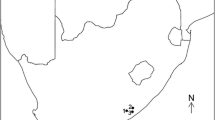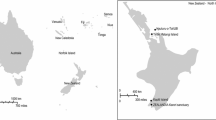Abstract
Psittacine beak and feather disease (PBFD) is a viral disease distributed worldwide with a potentially critical impact on many rare parrots. While efforts have been made to determine its prevalence in wild and captive psittacines, only limited work has been done to document complete genomes of its causative agent, beak and feather disease virus (BFDV). Here, we describe five full genomes of BFDV isolated from wild specimens of an endemic New Zealand parrot, the red-fronted parakeet (Cyanoramphus novaezelandiae). The isolates share >99% nucleotide similarity amongst themselves and ~91–92% similarity to BFDV isolates from southern Africa, Europe and Australia. A maximum-likelihood (ML) phylogenetic tree including 42 other full-genome sequences indicated that the five isolates from red-fronted parakeets represent an undescribed genotype of BFDV. These isolates are evolutionarily most closely related to the Cacatuini isolates from Thailand and the Lorinae isolates from Australia in the rep gene ML tree; however, in the cp ML tree, the evolutionary relationship is closer to viruses found in the Psittacini.



Similar content being viewed by others
References
Duffy S, Shackelton LA, Holmes EC (2008) Rates of evolutionary change in viruses: patterns and determinants. Nat Rev Genet 9:267–276
Fauquet CM, Briddon RW, Brown JK, Moriones E, Stanley J, Zerbini M, Zhou X (2008) Geminivirus strain demarcation and nomenclature. Arch Virol 153:783–821
Firth C, Charleston MA, Duffy S, Shapiro B, Holmes EC (2009) Insights into the evolutionary history of an emerging livestock pathogen: porcine circovirus 2. J Virol 83:12813–12821
Gerlach H (1994) Circoviridae-psittacine beak and feather disease virus. In: Ritchie BW, Harrison GT, Harrison LR (eds) Avian medicine: principles and practice. Wingers Publishing Incorporation, Lake Worth, FL, pp 894–903
Guindon S, Gascuel O (2003) A simple, fast, and accurate algorithm to estimate large phylogenies by maximum likelihood. Syst Biol 52:696–704
Ha HJ, Anderson IL, Alley MR, Springett BP, Gartrell BD (2007) The prevalence of beak and feather disease virus infection in wild populations of parrots and cockatoos in New Zealand. New Zeal Vet J 55:235–238
Hale KA, Briskie JV (2007) Decreased immunocompetence in a severely bottlenecked population of an endemic New Zealand bird. Anim Conserv 10:2–10
Heath L, Martin DP, Warburton L, Perrin M, Horsfield W, Kingsley C, Rybicki EP, Williamson AL (2004) Evidence of unique genotypes of beak and feather disease virus in southern Africa. J Virol 78:9277–9284
Heath L, Williamson AL, Rybicki EP (2006) The capsid protein of beak and feather disease virus binds to the viral DNA and is responsible for transporting the replication-associated protein into the nucleus. J Virol 80:7219–7225
Kock ND, Hangartnar PU, Lucke V (1993) Variation in clinical disease and species susceptibility to psittacine beak and feather disease in Zimbabwean lovebirds. Onderstepoort J Vet Res 60:159–161
Lefeuvre P, Lett JM, Varsani A, Martin DP (2009) Widely conserved recombination patterns among single-stranded DNA viruses. J Virol 83:2697–2707
Martin DP, Williamson C, Posada D (2005) RDP2: recombination detection and analysis from sequence alignments. Bioinformatics 21:260–262
Meehan BM, Creelan JL, McNulty MS, Todd D (1997) Sequence of porcine circovirus DNA: affinities with plant circoviruses. J Gen Virol 78:221–227
Niagro FD, Forsthoefel AN, Lawther RP, Kamalanathan L, Ritchie BW, Latimer KS, Lukert PD (1998) Beak and feather disease virus and porcine circovirus genomes: intermediates between the geminiviruses and plant circoviruses. Arch Virol 143:1723–1744
Ortiz-Catedral L, McInnes K, Hauber ME, Brunton DH (2009) First report of psittacine beak and feather disease (PBFD) in wild red-crowned parakeets (Cyanoramphus novaezelandiae) in New Zealand. Emu 109:244–247
Pass DA, Perry RA (1984) The pathology of psittacine beak and feather disease. Aust Vet J 61:69–74
Perrin M, Downs C, Symes C (1999) Final blows for the cape parrot? PsittaScene 11:12–13
Posada D (2006) ModelTest Server: a web-based tool for the statistical selection of models of nucleotide substitution online. Nucleic Acids Res 34:W700–W703
Raidal S, McElnea CL, Cross GM (2008) Seroprevalence of psittacine beak and feather disease in wild psittacine birds in New South Wales. Aust Vet J 70:137–139
Ritchie BW, Niagro FD, Lukert PD, Steffens WL, Latimer KS (1989) Characterization of a new virus from cockatoos with psittacine beak and feather disease. Virology 171:83–88
Ritchie PA, Anderson IL, Lambert DM (2003) Evidence for specificity of psittacine beak and feather disease viruses among avian hosts. Virology 306:109–115
Seutin G, White BN, Boag PT (1991) Preservation of avian blood and tissue samples for DNA analyses. Can J Zool—Rev Can Zool 69:82–90
Shepherd DN, Martin DP, Lefeuvre P, Monjane AL, Owor BE, Rybicki EP, Varsani A (2008) A protocol for the rapid isolation of full geminivirus genomes from dried plant tissue. J Virol Methods 149:97–102
Tamura K, Dudley J, Nei M, Kumar S (2007) MEGA4: Molecular Evolutionary Genetics Analysis (MEGA) software version 4.0. Mol Biol Evol 24:1596–1599
Thompson JD, Higgins DG, Gibson TJ (1994) Clustal-W—improving the sensitivity of progressive multiple sequence alignment through sequence weighting, position-specific gap penalties and weight matrix choice. Nucleic Acids Res 22:4673–4680
Todd D (2000) Circoviruses: immunosuppressive threats to avian species: a review. Avian Pathol 29:373–394
Tompkins DM, Mitchell RA, Bryant DM (2006) Hybridization increases measures of innate and cell-mediated immunity in an endangered bird species. J Anim Ecol 75:559–564
Vega-Rocha S, Gronenborn B, Gronenborn AM, Campos-Olivas R (2007) Solution structure of the endonuclease domain from the master replication initiator protein of the nanovirus faba bean necrotic yellows virus and comparison with the corresponding geminivirus and circovirus structures. Biochemistry (US) 46:6201–6212
Acknowledgments
This research was completed with the logistical and financial support of the University of Canterbury (Science Faculty Early Career Grant), New Zealand Department of Conservation, Massey University (Institute of Natural Sciences), the University of Auckland (School of Biological Sciences), Motuihe Island Trust, Tawharanui Open Sanctuary Supporters Inc., Auckland Regional Council, and National Council of Science from Mexico (CONACYT). This research was conducted under full approval of the New Zealand Department of Conservation (permits AK-15300-RES, AK-20666-FAU and AK-22857-FAU) and Massey University Animal Ethics Committee (protocols MUAEC 07/138 and 08/24). MM is supported by the New Zealand Foundation for Research, Science and Technology (UOCX0601). We thank the numerous volunteers who assisted with capture and processing of red-fronted of parakeets on Little Barrier Island. Special thanks go to Shane McInnes and Liz Whitwell (Department of Conservation) who greatly facilitated our work on Little Barrier Island.
Author information
Authors and Affiliations
Corresponding author
Electronic supplementary material
Below is the link to the electronic supplementary material.
Rights and permissions
About this article
Cite this article
Ortiz-Catedral, L., Kurenbach, B., Massaro, M. et al. A new isolate of beak and feather disease virus from endemic wild red-fronted parakeets (Cyanoramphus novaezelandiae) in New Zealand. Arch Virol 155, 613–620 (2010). https://doi.org/10.1007/s00705-010-0607-2
Received:
Accepted:
Published:
Issue Date:
DOI: https://doi.org/10.1007/s00705-010-0607-2




